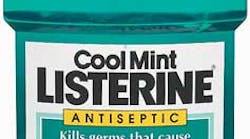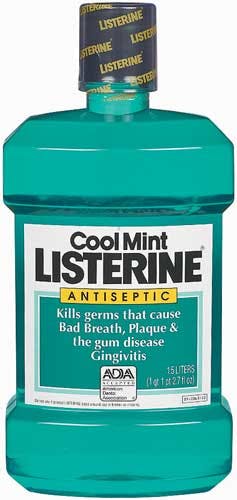By Christine Charles, RDH
Antimicrobial mouthrinses provide anti-plaque and anti-gingivitis benefits beyond brushing and flossing alone. An antimicrobial mouthrinse where the active ingredient is the fixed combination of four essential oils (EO), thymol, menthol, eucalyptol and methyl salicylate in a hydroalcohol solution (pharmaceutical grade ethanol functions as a solvent, a vehicle for the active ingredients and as a preservative in a mouthrinse), has been proven clinically effective and safe in over 50 clinical trials, including 6-month trials with plaque reductions up to 70.0%(1) and gingivitis reductions up to 36%(1,2) compared with negative control.
Antimicrobial mouthrinses provide anti-plaque and anti-gingivitis benefits beyond brushing and flossing alone. An antimicrobial mouthrinse where the active ingredient is the fixed combination of four essential oils (EO), thymol, menthol, eucalyptol and methyl salicylate in a hydroalcohol solution (pharmaceutical grade ethanol functions as a solvent, a vehicle for the active ingredients and as a preservative in a mouthrinse), has been proven clinically effective and safe in over 50 clinical trials, including 6-month trials with plaque reductions up to 70.0%(1) and gingivitis reductions up to 36%(1,2) compared with negative control.
Sharma, et al, showed the clinically significant incremental benefit of including an EO antimicrobial mouthrinse in a daily mechanical oral regimen of brushing and flossing.(3) Mechanical oral hygiene techniques generally focus on the teeth, but teeth comprise only about 25% of the surface area of the mouth. Bacteria are also prevalent on the other 75% of the mouth’s surface area, in bacterial reservoirs on the tongue, cheek, palate and oral mucosa.(4)A mouthrinse can reach the rest of the mouth, where a toothbrush and floss cannot. EO works by killing planktonic and biofilm-associated bacteria and a broad spectrum of bacteria and yeasts associated with halitosis, gingivitis and periodontitis by: (1) disrupting bacterial cell membranes and cell walls, (2) inhibiting bacterial growth and development, (3) inhibiting glucosyltransferase (gtf) enzymes, reducing extracellular polysaccharide (EPS) formation, and (4) reducing plaque endotoxin levels.(5) The scientific literature supports the safety of EO mouthrinses,(7-9) including use in xerostomic patients,(8) and evidence that EOs do not cause the development of resistant, opportunistic or pathogenic organisms.(11)
Furthermore, alcohol containing mouthrinses have been shown to have no association with oral cancer risk as Dr. Peter Boyle concluded in a presentation entitled “Mouthwash Use and Oral Cancer Risk: Quantitative Use and Meta-Analysis of Epidemiologic Studies” at the Academy of Oral Medicine annual session April 6, 2011: “This quantitative analysis of all published epidemiological studies of mouthwash use and oral malignancy revealed (1) no statistically significant association between mouthwash use and risk of oral cancer including no significant trend in risk with increasing daily use; and (2) no association between use of mouthwash containing alcohol and oral cancer risk.” Professional Associations recognize the benefit that antimicrobial mouthrinses with proven efficacy contribute to oral hygiene. The ADA’s oral hygiene recommendations include a statement about antimicrobial mouthrinse efficacy.(12) The Canadian Dental Hygienists Association recommends including rinsing in a regimen of brushing and flossing.(13)References
1. Gunsolley JC. A meta-analysis of six-month studies of antiplaque and antigingivitis agents. J Am Dent Assoc. 2006; 137: 1649-1657.2. Sharma NC, Araujo MWB, Wu M, Qaqish J, Charles CH, Superiority of an essential oil mouthrinse when compared with a 0.05% cetylpyridinium chloride containing mouthrinse: a six-month study, International Dental Journal, (2010) 60, 175-180.3. Overholser CD, Meiller TF, DePaola LG, Minah GE, Niehaus C. Comparative effects of 2 chemotherapeutic mouthrinses on the development of supragingival plaque and gingivitis. J Clin Periodontol. 1990; 17:575-79.4. Sharma N, Charles CH, Lynch MC, et al. Adjunctive benefit of an essential oil-containing mouthrinse in reducing plaque and gingivitis in patients who brush and floss regularly: a six-month study. J Am Dent Assoc. 2004; 135: 496-504.5. Barnett ML. The rationale for the daily use of an antimicrobial mouthrinse. J Am Dent Assoc 2006;137:16S-21S.6. DePaola LG, et al. Safety and efficacy of antimicrobial mouthrinses in clinical practice. Access, September – October 2007.7. Lemos-Junior CA, Villoria GBM. Reviewed evidence about the safety of alcohol based mouthrinses. Braz Oral Res 2008; 22 Special Issue 1:24-31.8. Walsh LJ. Are alcohol containing dental mouthrinses safe? A critical look at the evidence. Australian Dent Practice 2008, 64-68.9. La Vecchia C. Mouthwash and oral cancer risk: An update. Oral Oncol 2009, Mar;45(3):198-200.10. Fischman SL, Aguirre A, Charles CH. Use of essential oil-containing mouthrinses on salivary by xerostomic individuals: determination of potential for oral mucosal irritation. Am J Dent 2004;17(1):23-26.11. Minah GE, DePaola LG, Overholser CD, Meiller TF, et al. Effects of 6 months use of an antiseptic mouthrinse on supragingival dental plaque microflora. J Clin Perio 1989; 16:347-352.12. American Dental Association. Oral Health Topics A-Z: Cleaning Your Teeth and Gums (Oral Hygiene). www.ada.org/2624.aspx. Accessed March 2010.13. www.cdha.ca/AM/Template.cfm, accessed Feb 18, 2011.
1. Gunsolley JC. A meta-analysis of six-month studies of antiplaque and antigingivitis agents. J Am Dent Assoc. 2006; 137: 1649-1657.2. Sharma NC, Araujo MWB, Wu M, Qaqish J, Charles CH, Superiority of an essential oil mouthrinse when compared with a 0.05% cetylpyridinium chloride containing mouthrinse: a six-month study, International Dental Journal, (2010) 60, 175-180.3. Overholser CD, Meiller TF, DePaola LG, Minah GE, Niehaus C. Comparative effects of 2 chemotherapeutic mouthrinses on the development of supragingival plaque and gingivitis. J Clin Periodontol. 1990; 17:575-79.4. Sharma N, Charles CH, Lynch MC, et al. Adjunctive benefit of an essential oil-containing mouthrinse in reducing plaque and gingivitis in patients who brush and floss regularly: a six-month study. J Am Dent Assoc. 2004; 135: 496-504.5. Barnett ML. The rationale for the daily use of an antimicrobial mouthrinse. J Am Dent Assoc 2006;137:16S-21S.6. DePaola LG, et al. Safety and efficacy of antimicrobial mouthrinses in clinical practice. Access, September – October 2007.7. Lemos-Junior CA, Villoria GBM. Reviewed evidence about the safety of alcohol based mouthrinses. Braz Oral Res 2008; 22 Special Issue 1:24-31.8. Walsh LJ. Are alcohol containing dental mouthrinses safe? A critical look at the evidence. Australian Dent Practice 2008, 64-68.9. La Vecchia C. Mouthwash and oral cancer risk: An update. Oral Oncol 2009, Mar;45(3):198-200.10. Fischman SL, Aguirre A, Charles CH. Use of essential oil-containing mouthrinses on salivary by xerostomic individuals: determination of potential for oral mucosal irritation. Am J Dent 2004;17(1):23-26.11. Minah GE, DePaola LG, Overholser CD, Meiller TF, et al. Effects of 6 months use of an antiseptic mouthrinse on supragingival dental plaque microflora. J Clin Perio 1989; 16:347-352.12. American Dental Association. Oral Health Topics A-Z: Cleaning Your Teeth and Gums (Oral Hygiene). www.ada.org/2624.aspx. Accessed March 2010.13. www.cdha.ca/AM/Template.cfm, accessed Feb 18, 2011.
Christine Charles, RDH, is Associate Director, Scientific & Professional Affairs, Johnson & Johnson Consumer & Personal Healthcare Products Worldwide, a Division of Johnson & Johnson Consumer Companies, Inc.To read another article in RDH eVillage FOCUS by Christine Charles, go to article.









